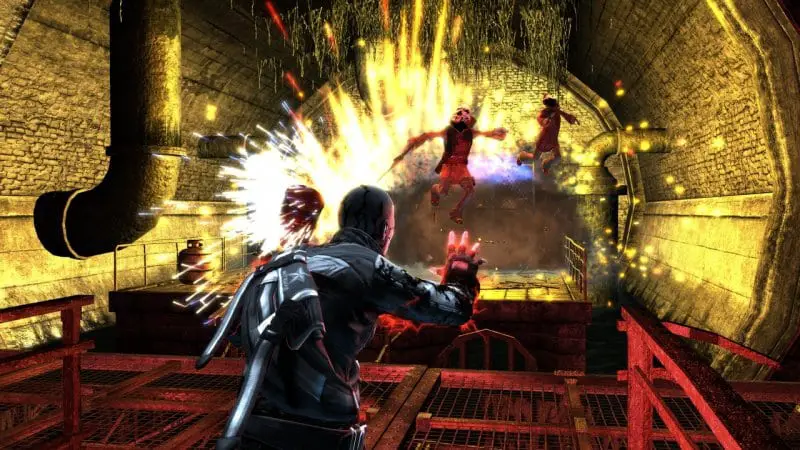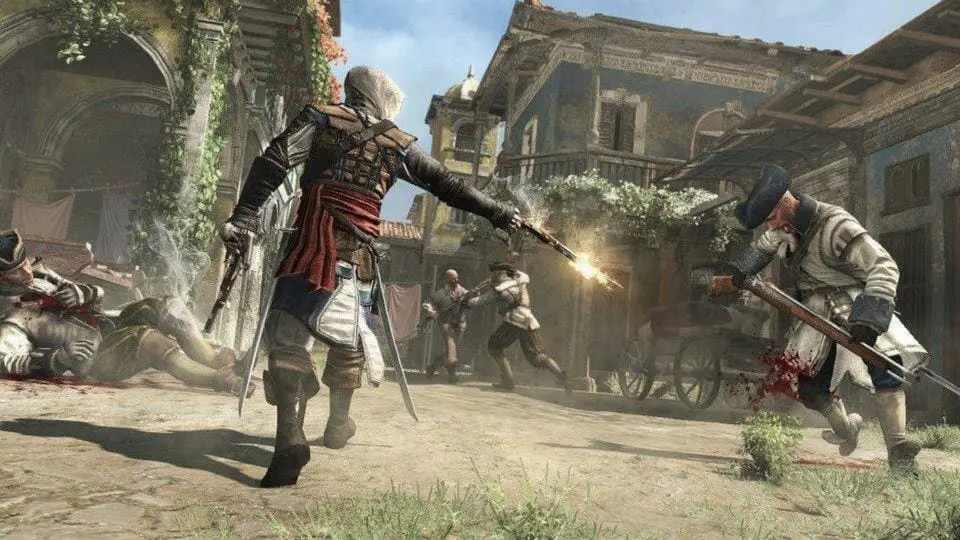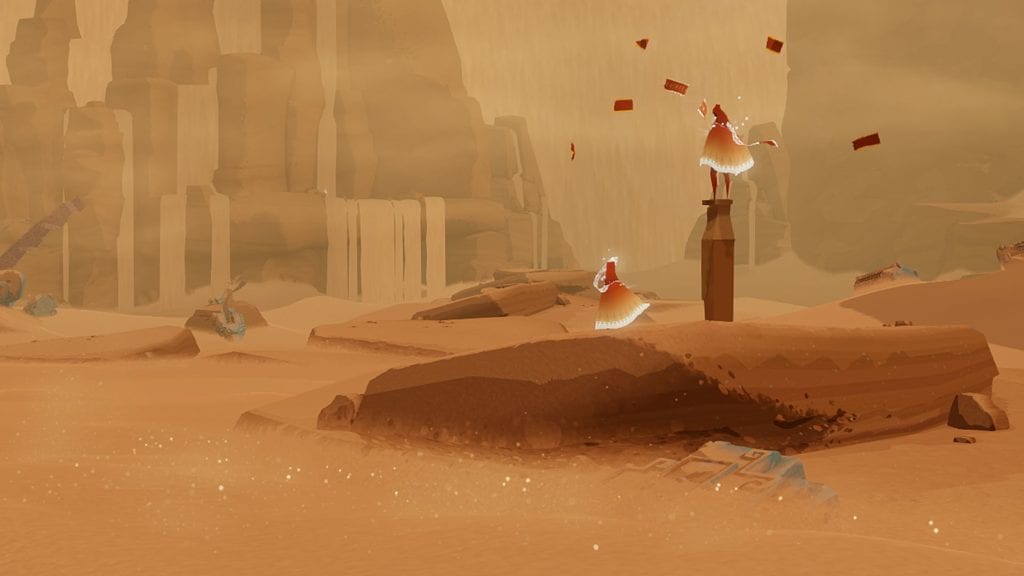In Assassin’s Creed IV: Black Flag, you play as lawless pirate Edward Kenway. Based on a real historical figure, Kenway leads a crew that earns a living by attacking ships, killing its defenders until they surrender and stealing their cargo.
Sailing out into the sea one day, I saw a small ship and decided to let loose my cannons. The weapons struck home, and I was suddenly informed that the real Edward Kenway did not harm civilians. It was clear that me wantonly attacking civilians would not be tolerated by the game. This was passing odd, as Kenway had been running around casually murdering people since the game’s beginning. Most were not established as being reprehensible people; they were merely the unfortunate souls that happened to be standing in between Kenway and his goals. The game did not censure me for murdering them.
Which is why I started thinking about who video games find it permissible to kill in large numbers. The focus is not on the big evil central antagonists which heroes must defeat to save the day. Instead I am examining the generic grunts of AAA Games and trying to figure out who is permitted to die at a hero’s hands without opening them up to moral judgement.
Non-Humans
My main focus is to establish which humans that video games deem it permissible to murder, but I would be remiss from pointing out an obvious truth first. Non-humans almost always exist in games so that they can be fought and killed.
In almost all games involving violence (which is virtually every AAA Games) the hero is given carte blanche to slaughter animals. More often than not their deaths are a central component in a crafting system. It would appear that there are not many vegans at the helm of major gaming studious.
Monsters have it even worse, by virtue of them not being tied to creatures that exist in reality. No one mourns the death of an Orc in any given Lord of the Rings game, even when they are demonstrated to have personalities and be capable of intelligent thought.
Games set in fantasy or sci-fi universes have a much easier time in coming up with credible threats to the player-character that the player will not find guilty in dispatching. It is the games that dare to have some sense of realism which must pit the hero against humans, and it is these games that are more relevant for this discussion.
The One-Dimensional Enemy
It would be insane to expect developers to give every last grunt a distinct personality. There are simply not enough hours in the day (or enough dollars in the budget) to make Prison Guard #145 as in depth a character as Sephiroth or Saruman. It is inevitable that generic enemies would wind up having generic personalities.
There is, however, a dual function to making enemies one-dimensional. The less they seem like realistic people, the more they can be dehumanised, and the easier it is to have the player mow them down in their hundreds and thousands. How else do you explain a situation like the first Infamous game? Cole McGrath (when he is being a hero at least) ends up empathising with the three main villains after he has defeated them and does not end up killing any of them. In the end there was too much humanity in them which, despite their many sins, did not justify their murder in Cole’s eyes.
Which would be all well and good, if Cole does not spend most of the game killing their subordinates. Yes these enemies are exclusively characterised as being indiscriminately violent, but they were also directed to be violent by the three main villains. Why do the Big Bads get let off the hook, but not grunts?
Because Cole (i.e. the player) is not given any opportunity to empathise with their humanity, because they have not been designed to have any humanity. There being one-dimensional makes it so their slaughter is entirely guiltless.

The Soldier
The best way to make someone feel justified in shooting at a human being is to have them shoot first. It is thus no surprise that quasi-military forces make up the bulk of enemies in any given video game.
Often times these military or quasi-military organisations are painted as being amoral or outright evil. Members of fighting forces such as Oblivion’s Mythic Dawn (who are an assassination-happy cult that worships essentially the God of Destruction) are probably not nice people, nor is anyone who still works for Umbrella Corp in Resident Evil after they have caused several zombie outbreaks likely to be a swell dude.
Yet there is an oddity that occurs when a soldier is not portrayed as a bad person. Returning to Black Flag, the game that expressly told me not to kill civilians, which does not care how many soldiers I kill. From historical context we all know that the British and Spanish soldiers who stood guard outside palaces and warehouses are more than likely working class guys just trying to make a living.
Yet because they have guns, and could thus theoretically be a threat, our hero is in no way reprimanded for murdering as many soldiers as he pleases. This is despite most them only reaching for their guns after Kenway has already murdered someone. It appears putting a man in a uniform is all it takes to make his death permissible to game designers.
Gender Divisions
Here is a list of games that all have one very odd thing in common (at least in their early installments); Uncharted, Infamous, Just Cause, Sly Cooper, Jak and Daxter, Assassin’s Creed, Call of Duty, Half Life, The Last of Us, and Grand Theft Auto. Can you guess what is the commonality that these games share?
In all of these games the generic enemies are exclusively male.
Is that not slightly weird? Surely I cannot be the first person to notice this. More than likely this comes from designers being lazy (which is no excuse, but still the likeliest explanation). Either that or there was a memo that went around at some point which said the general public will complain if the hero winds up killing a few female enemies mixed in with the hundreds of males.
There is no real justification for why in these games there are apparently no female soldiers, police officers, guards, mercenaries or militia. Perhaps Assassin’s Creed can argue historical accuracy in some circumstances, but even then these are the games that constantly throw sci-fi elements into everything, so I am not sure they have much of a leg to stand on. Regardless, some of these games listed are cartoons, so they can hardly fall back on the realism defence.
It gets particularly egregious in a game like Uncharted 3, where the main villain is female and yet seemingly only employs men in her shadowy organisation. She ends up dying completely independent of the protagonist’s actions, incidentally, and the final fight winds up being against her right hand man.
True diversity would mean equal amounts of all types of characters. While the industry could certainly do with more female led games, so too could it do with more woman in antagonistic roles.

Obstacles
Alright, so we have narrowed down the field considerably. It seems that the ultimate generic enemy is a one-dimensional male soldier, at least going by the industry standard grunts. Yet there are of course exceptions to this template. There are a bunch of female soldiers in The Elder Scrolls series, some well-motivated grunts in The Last of Us and (as was mentioned earlier) many games rely on literal monsters to give the hero something to fight.
Yet there is one true unifier when it comes to video game grunts. There is one type of enemy that features in virtually all games, regardless of genre, which the player always feels justified in killing. The one enemy that it is always permissible to kill is one that is standing in the way of your goals.
Think about it. In most games enemies do not get aggressive until you do first, so self-defense is hardly the optimum excuse here. Almost every murder in a video game comes as a result of some unfortunate soul happening to be blocking your progress. It does not matter if they are a guard protecting some jewels you are attempting to steal, a combatant protecting their city, or a monster just trying to live quietly in a cave you have been exploring. Provided they in some way hinder your progress, their death is immediately justified.
This is pretty disturbing from a Watsonian standpoint, and unflattering from a Doylist one. Video game characters need only be hindered by their fellow man to resort to murder, while video game players have been trained since the 80’s to shoot first whenever a problem arises. Thus the perfect video game grunt is not necessarily a one-dimensional male soldier, but rather just any given living organism that has become an obstacle.
A Better Enemy
Undertale gets a lot of mileage out of the fact that it really is not justifiable to kill things just because they are in your way. In makes the point that the self-defense argument really falls apart once you are given the ability to save and load your progress. It is perhaps not the best situation in the world that most video game grunts die merely because they are in the way. How then could we make the situation better?
A good first step would be to remember to actually characterise enemies as being, you know, bad in some way. If your story revolves around a supposedly heroic protagonist, then the people they fight should be worse than them. Establishing the grunts as being ruthless, reckless, sadistic or seeking supremacy will go a long way to making the player character’s actions feel more heroic.
Another step would be to limit the body count. Uncharted always ends up being a target for this, but it is a problem that happy-go-lucky Nathan Drake kills thousands of people over the course of the series. Having the hero only kill a few people, and only when they pose a serious threat, would also be a good idea.
Lastly, and this might sound crazy, but maybe make it so every game does not revolve around violence. Again we can point to Undertale as an example of how a video game character being a pacifist can create really interesting problem solving mechanics. How about more stealth games were you really cannot kill anyone? How about more games like Journey where exploration is held above all else?
I am not saying that all video games should give up on being violent, or that there is nothing ever worth fighting for, but maybe the industry would thrive if AAA Games stopped almost exclusively being experiences with massive body counts.

Conclusion
To return to the beginning, Edward Kenway is a pirate who kills people every day with the sole purpose of getting rich. This is literally his motivation (in the first dozen or so hours), his desire to become wealthy through whatever means necessary. Why on Earth would he care about the lives of civilians?
Immersion is everything in gaming. The strength of the narrative so often rests on how much you feel as though you are the player character. Questioning Kenway’s bizarre moral double standards breaks immersion. I mean, here I am writing two thousand words stemming from this question rather than finishing the game.
This little exercise in finding the perfect gaming enemy was really just an excuse to explore the tropes designers so often fall back on. It is most likely laziness that leads so many enemies to be one-dimensional male soldiers rather than any kind of agenda. I just argue that we gamers are entitled to ask for a little more effort from the people producing art.
Thinking things through a little more can help avoid raising some odd moral implications. Working a little harder to characterise generic enemies could make for a richer gaming experience. Finally, if there is little within the story to justify a violent protagonist, then perhaps forgoing violence might not be the worst option to choose.

